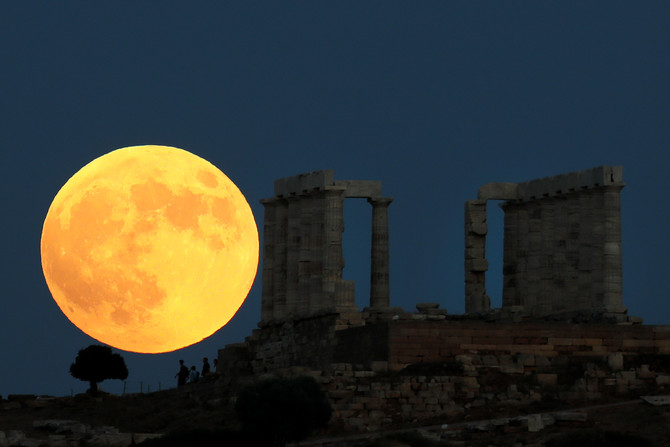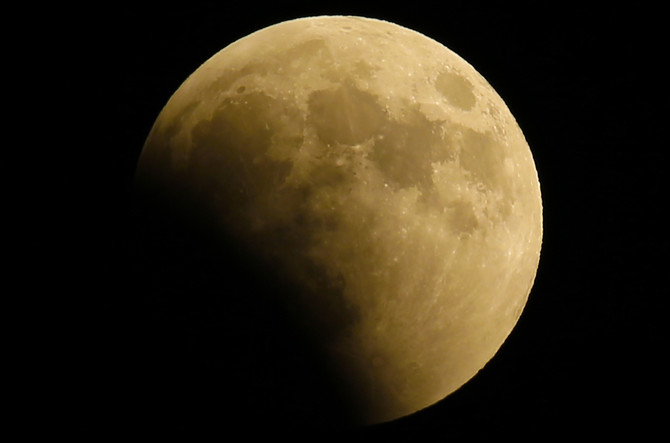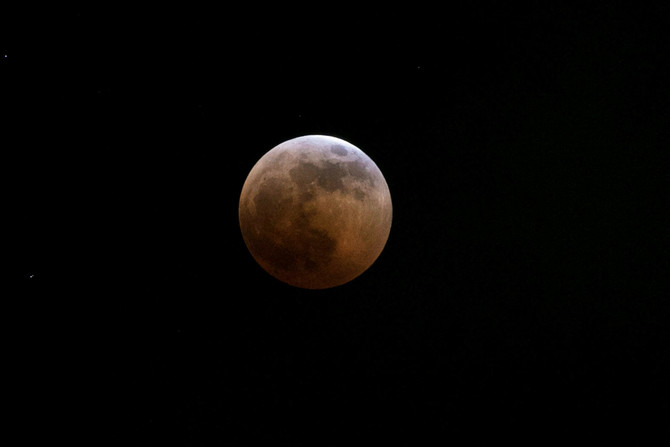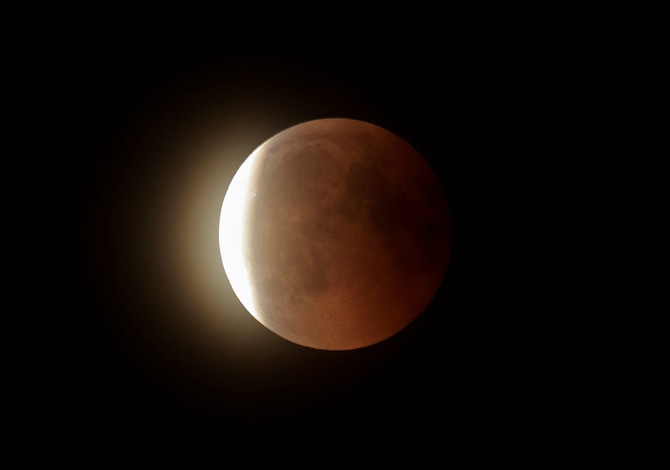DUBAI/JEDDAH: A blood-red moon dazzled star gazers across much of the world on Friday when it moved into Earth’s shadow for the longest lunar eclipse of the 21st Century.
From the Cape of Good Hope to the Middle East, and from the Kremlin to Sydney Harbor, thousands of people turned their eyes to the stars to watch the moon, which turned dark before shining orange, brown and crimson in the shadow.
The total eclipse lasted 1 hour, 42 minutes and 57 seconds, though a partial eclipse preceded and follows, meaning the moon will spend a total of nearly 4 hours in the Earth’s umbral shadow, according to NASA.
The fullest eclipse was visible from Europe, Russia, Africa, the Middle East, and much of Asia and Australia though clouds blocked out the moon in some places.
The eclipse will not be visible from North America or most of the Pacific.
Reuters charted the eclipse from across the world, capturing a shimmering orange and red moon above Cairo, the Temple of Poseidon in Cape Sounion, near Athens, the Bavarian village of Raisting in Germany, Rio beach in Brazil and Johannesburg.
11:00 p.m. GMT`
In Nairobi, Kenyans watched as the moon darkened.
“This is what life is all about: Magical moments like this,” said Teddy Muthusi as he watched from Uhuru Park in Nairobi. “It’s just beautiful. It’s well worth it.”
On the banks of India’s Ganges, temples were closed ahead of the eclipse. Enthusiasts watched through telescopes at the Marina South Pier in Singapore and at the Al Sadeem Observatory in Al Wathba near Abu Dhabi.
View our photo gallery: Night of the ‘Blood Moon’
Across Africa people turned to the sky, watching the reddish shadow slide up the moon’s surface. In Somalia, some hurried to mosques for special prayers. In South Sudan, some dared to take photos in a war-torn country where using a camera in public is discouraged.
In Ethiopia’s capital, Addis Ababa, people at an open-air restaurant admired a rare clear view during the rainy season, comparing a live NASA webcast to what they saw above. Then clouds rolled in.
“Dem yelebesech chereka,” some murmured — Amharic for “blood moon.”
“The reason that the moon turns red is because atmospheric scattering causes red light to pass through the atmosphere and the composition of the atmosphere can change if volcanic eruptions or forest fires occur,” said Tom Kerss, an astronomer with the Royal Observatory Greenwich.
“And the density of dust increasing in the atmosphere can cause the moon to appear a particularly deep red, and indeed it has the same effect on our sunsets and sunrises.”In a special treat, Mars is also at its closest approach to Earth this week since 2003, making it appear bigger and brighter.
Excited skywatchers on social media shared photos of the bright planet just to the right of the moon.
North America missed out on Friday’s lunar eclipse but can look forward to the next one on Jan. 21, 2019, according to NASA.Hundreds of people in Australia paid to watch the eclipse from the Sydney Observatory before sunrise.
When the moon moved into the conical shadow of the earth, it went from being illuminated by the sun to being dark. Some light, though, still reaches it because it is bent by the Earth’s atmosphere.In a special treat, Mars is in opposition on Friday — meaning the planet and the sun will be on exact opposite sides of the Earth and will shine its best. Mars is also at its closest approach to Earth this week since 2003, making it appear bigger and brighter.
The #lunareclipse2018 will be visible on the 27th July in large parts of #Australia, #Asia, #Africa, #Europe, and #SouthAmerica. Totality will last for 103 minutes, making it the longest #eclipse of the 21st century #LunarEclipse #BloodMoon || https://t.co/Zmg7z511i7 pic.twitter.com/akgO6SqwCl
— Arab News (@arabnews) July 27, 2018
09:35 pm GMT
06:14 pm GMT
The longest “blood moon” eclipse this century began on Friday, coinciding with Mars’ closest approach in 15 years to treat skygazers across the globe to a thrilling celestial spectacle.
Unlike with a solar eclipse, viewers will need no protective eye gear to observe the rare display.
For about half the world, the moon will be partly or fully in Earth’s shadow from 1714 to 2328 GMT — six hours and 14 minutes in all.
The period of complete eclipse — known as “totality,” when the moon appears darkest — will last from 1930 to 2113 GMT.
At the same time, Mars will hover near the moon in the night sky, easily visible with the naked eye.
Amateur astronomers in the southern hemisphere will be best-placed to enjoy the spectacle, especially those in southern Africa, Australia, India and Madagascar, though it will also be partly visible in Europe and South America.
05:50 pm GMT
A total lunar eclipse happens when Earth takes position in a straight line between the moon and sun, blotting out the direct sunlight that normally makes our satellite glow whitish-yellow.
The moon travels to a similar position every month, but the tilt of its orbit means it normally passes above or below the Earth’s shadow — so most months we have a full moon without an eclipse.
When the three celestial bodies are perfectly lined up, however, the Earth’s atmosphere scatters blue light from the sun while refracting or bending red light onto the moon, usually giving it a rosy blush.
The long duration of this eclipse is partly due to the fact that the moon will make a near-central passage through Earth’s umbra — the darkest, most central part of the shadow.
Our constant companion will also be at the farthest point on its orbit from Earth, making its movement across the sky slower from our perspective, thus spending longer in the dark.
NASA, meanwhile, has called out social media hoaxers claiming that Mars will appear as big as the moon during the eclipse.
“If that were true, we’d be in big trouble given the gravitational pulls on Earth, Mars, and our moon!” the NASA website states.
Mars will more likely appear as a very bright star.
03:30 pm GMT
Across the world, from the Taj Mahal to the Eiffel Tower, people will turn their eyes to the sky, hoping to see the blood moon, which appears orange, brown or crimson as sunlight is bent through the earth’s atmosphere.
The total eclipse will last 1 hour, 42 minutes and 57 seconds, though a partial eclipse precedes and follows, meaning the moon will spend a total of 3 hours and 54 minutes in the earth’s umbral shadow, according to NASA.
The fullest eclipse, at 2022 GMT, will be visible from Europe, Russia, Africa, the Middle East, much of Asia and Australia.

When the moon moves into the conical shadow of the earth, it goes from being illuminated by the sun to being dark. Some light, though, will still reach it because it is bent by the earth’s atmosphere.
At the same time, Mars will be traveling closer to earth than it has been since 2003, so some observers may be able to see what looks like an orange-red star — and is in fact the red planet.



































